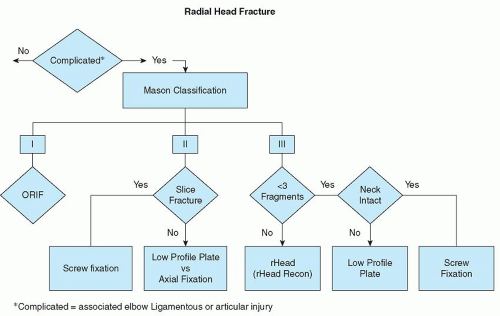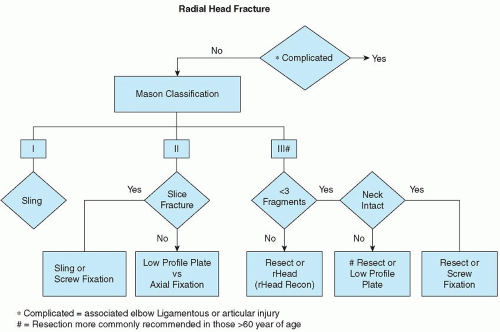Fracture of the Radial Head
Bernard F. Morrey
INTRODUCTION
The surgical management of fracture of the radial head is primarily a function of the presence or absence of associated injuries (1,2). We have assessed the Mayo experience and demonstrated a correlation between the Mason type of fracture and associated injuries and describe a classification scheme to reflect this association (Table 5-1). In general, any type II or III fracture should be considered to have an associated lesion, unless proven otherwise (3).
The spectrum of management covers the broad potential of resection (4,5), internal fixation (6,7), or replacement (8,9,10,11 and 12). The indications for radial head restoration are principally related to associated injuries that dictate the presence of a functioning radiohumeral articulation. Management of the uncomplicated fracture according to the Mason grade is shown in Figure 5-1. Our management for those with associated injuries is shown in Figure 5-2.
OPEN REDUCTION AND INTERNAL FIXATION
Indications
Those circumstances in which the patient is young and active and in whom a radial articulation would be of value
Fractures with less than three fragments (13), fractures in which there is associated articular or ligamentous injury, including
Contraindications
Circumstances in which a radial head fixation is not necessary and uncomplicated fractures or when there is more than three fragments
If open reduction and internal fixation is possible and indicated, there are three broad categories of surgical technique:
Interfragmentary compression
Axial compression for radial neck fractures
Plate fixation
TABLE 5-1 General Classification of Radial Head Fracture Based on the Presence or Absence of Associated Injury | ||||||||||||||||||||||||||||||||||||||||||||||||||||||||||||
|---|---|---|---|---|---|---|---|---|---|---|---|---|---|---|---|---|---|---|---|---|---|---|---|---|---|---|---|---|---|---|---|---|---|---|---|---|---|---|---|---|---|---|---|---|---|---|---|---|---|---|---|---|---|---|---|---|---|---|---|---|
| ||||||||||||||||||||||||||||||||||||||||||||||||||||||||||||
OPERATIVE TECHNIQUES
In this chapter, we review our technique for ORIF using interfragmentary fixation, plate fixation for more than three fracture fragments and comminuted neck fractures, and crossed screw fixation for noncomminuted neck fractures.
Interfragmentary Compression
Indications Large single-fragment slice fractures or large two-fragment fractures (7)
Contraindications Comminution of the femoral neck
 FIGURE 5-2 Treatment logic employed for the management of radial head fractures occurring in the presence of associated injuries. |
Position The patient is placed supine, and the arm is brought across the chest
Surgical Incision
Associated injuries dictate the nature of the incision.
If associated injuries will require a medial exposure, a posterior incision is made. Otherwise, a lateral Kocher-type incision is performed (Fig. 5-3).
Stay updated, free articles. Join our Telegram channel

Full access? Get Clinical Tree









